Catalina Rojas, pintora escultora y muralista de luz, ha dado un giro al concepto tradicional de muralismo al iluminar sus pinturas y dibujos con la avanzada tecnología digital soportes urbanos y naturales.

Catalina Rojas González, artista visual. Nació en Santiago, Chile, el 2 de septiembre de 1971. Entre los años 1990 y 1994 realizó estudios de publicidad en la Universidad Diego Portales, de Santiago, obteniendo el título de publicista con mención en diseño audiovisual. Entre los años 1995 y 1997 obtuvo un diplomado en arte con mención en escultura y pintura en la Universidad Católica de Chile, Santiago. Entre los años 2001 y 2004 estudió licenciatura en artes visuales con mención en pintura en la Universidad Finis Terrae de Santiago de Chile, donde fue discípula de Bororo en la cátedra de dibujo.
El año 2006 fue profesora tutora de la cátedra de dibujo de paisa- je impartida por Valentina Cruz en la Universidad Finis Terrae en Santiago, Chile.
Entre los años 2008 y 2009 vivió en Michigan, Detroit, Estados Unidos, donde presentó sus trabajos en Expressiones Cultural Center in New London y también en el enclave de artistas I-Park, donde fue invitada a realizar una residencia para desarrollar un proyecto de intervención del paisaje —lagos y bosques— con sus pinturas y dibujos. También realizó la instalación en el bosque Tres Onas de una araucaria de noventa metros de largo extendida en el suelo de una colina. Todos estos trabajos fueron preparados para la Environmental Art Biennale 2009.
A comienzos del 2011 Catalina Rojas inauguró el Museo Arte de Luz, que consiste en una galería nocturna de arte al aire libre, abierta a todo público y gratuita, emplazada sobre la ribera del río Mapocho, convirtiéndolo en el único río iluminado del mundo con pintura y dibujos. Más de 10 millones de personas lo han visitado.
Su trayectoria ha sido reconocida por sus pinturas, esculturas y sus murales de luz proyectados en edificios patrimoniales y por crear el Museo Arte de Luz donde presentó el mural “Chile a la luz” para la celebración del Bicentenario de la República, además su búsqueda se basa en experimentar con plena libertad su mundo interior jugando a descubrir diversos soportes, hace un recorrido por distintos medios de expresión, pasando desde el dibujo espontáneo, a vivaces pinturas de pequeños y grandes formatos, hasta llegar a particulares esculturas.
Como declara Mario Toral, “su visión vuela más allá del cuadro de caballete”. Su obra libre de imposiciones intelectuales pero plena de historias, sueños, culturas y sobre todo de una profunda devoción por la creación y el arte.
Catalina ha participado en diversas exposiciones tanto en Chile como en el extranjero, tales como Estados Unidos Bienal de Artes Ambientales 2009 , Corea del Sur Plas 2017, Emiratos Arabes: Art Dubai 2019, Francia: Carruzel du Louvre Paris 2018, España: Centro Cultural Ateneo Madrid 2017, Argentina: Buenos Aires Biennial 2018 and Inglaterra: Londres Herrick Gallery 2019. Ha realizado una serie de esculturas, destaca entre ellas la creación de la escultura del Premios Pulsar (premio a la música Chilena), conocido anteriormente como el premios Altazor.
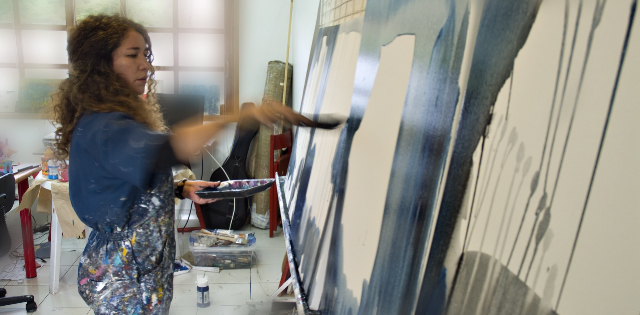
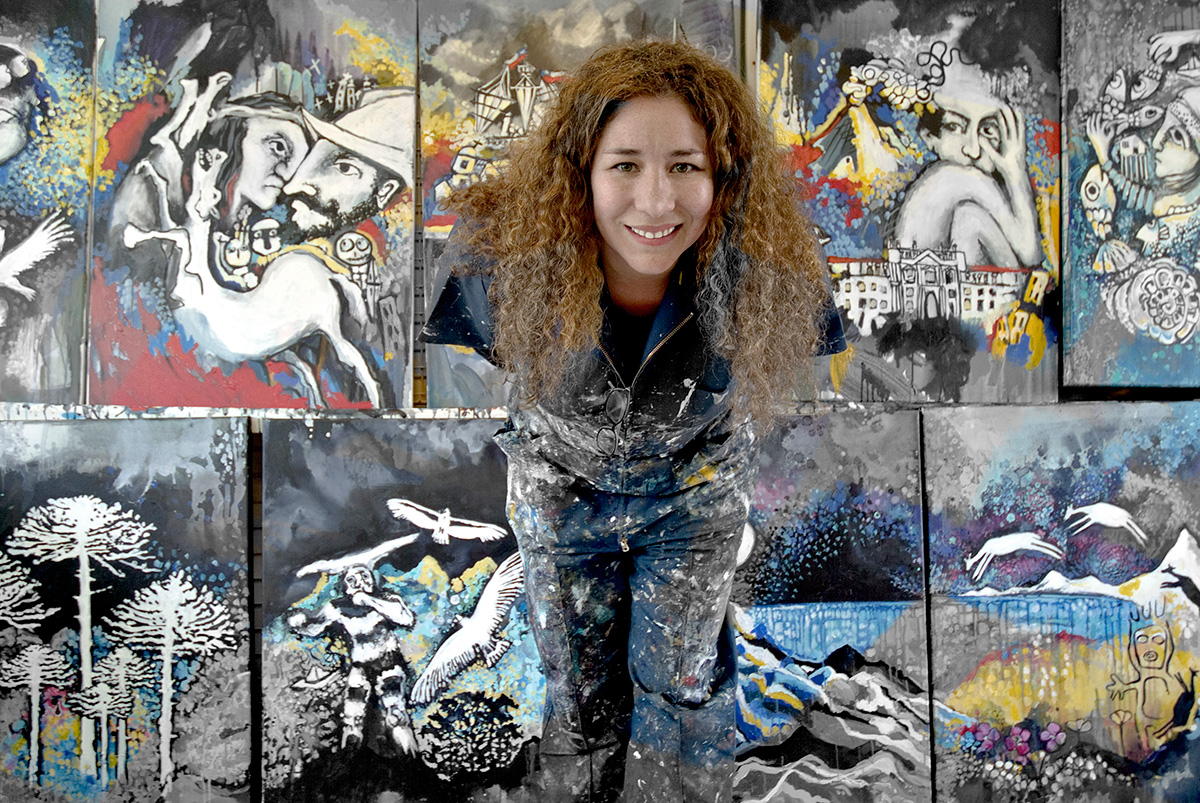
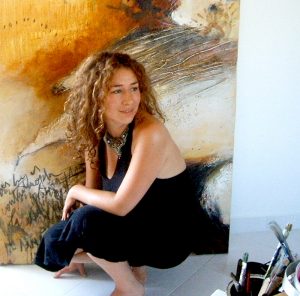
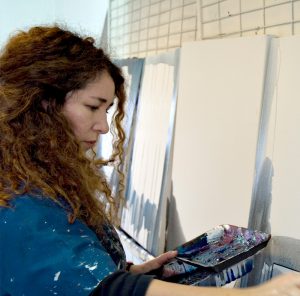
En 2019 tras un proceso de selección de ocho meses, la casa matriz de Samsung en Corea dio su veredicto: Catalina Rojas con un grupo de cuatro artistas destacados chilenos es elegida para exponer sus trabajos a través de Art Store, la plataforma mundial que te permite disfrutar de más de 1.200 obras de arte en tu televisor, cuando este se encuentra apagado.
La obra de Catalina se suma a un listado de instituciones de talla mundial que se asociaron a la plataforma, como el Museo del Prado, Victoria and Albert Museum, Saatchi Gallery y Magnum Photo. Es decir, en Art Store se pueden encontrar obras de artistas como Cézanne y Monet hasta fotógrafos actuales como Alex Webb y David Alan Harvey.
Destaca sus exposiciones en ART WEEK feria internacional de arte en Chile presenta una monumental realización, la cual indaga en las posibilidades de la pintura de caballete, más allá de la tela sobre el bastidor. Ya que en su mural de luz, el gesto y la mancha dan paso a la imagen en movimiento, donde el ritmo de esta narrativa está dado por la música que va guiando la mirada del espectador: 2021, 2023, 2021 Centro Cultural Estación Mapocho presentando los muralismo de luz: Volver a la luz, Pintura en el aire; Batalla de Venus 2023. También el 2022 en la entrada de la Casona Cultural de las Condes, en la misma feria.
2023 expone en el museo interactivo MUI su muralismo de Luz.
2023 expone sus obras y muralismo en la entrada de la Feria internacional del libro de Santiago. Fue visitada por mas de 300.000 mil personas.
2024 en la entrada de la feria internacional de arte Artweek en el Centro Cultural Estación Mapocho, nos deslumbrará una vez más con su muralismo de luz la obra “Naturaleza Cósmica”, experiencia inmersiva en 360°utilizando el soporte lumínico SkyDome para exhibir nuestra fauna y flora nativa del país. Además presento al interior de la feria, el SHOWROOM EPSON BY CATALINA ROJAS, con distintas técnicas de impresión digital de fine-art, como impresión de sus obras en telas, en papel y papel mural.
Biography
Catalina Rojas González, visual artist. She was born in Santiago, Chile, on September 2 1971. Between 1990 and 1994 she held advertising studies at the Universidad Diego Portales
in Santiago, obtaining her publicist degree with a mention in audiovisual design. Between 1995 and 1997 she obtained a postgraduate art degree with a mention in sculpture and painting at the Universidad Católica de Chile in Santiago. Between 2001 and 2004 she studied for her visual arts degree with a mention in painting at the Universidad Finis Terrae in Santiago, where she studied under Bororo at the drawing faculty. In 2006 she became a tutorial professor at the drawing chair imparted by Valentina Cruz at the Universidad Finis Terrae in Santiago.
Between 2008 and 2009 she lived in Michigan, Detroit, U.S.A., where she presented her works at the Expressiones Cultural Center in New London as well as at the I-Park artist enclave, where she was invited to hold a residence in order for her to develop a project for the intervention of the landscape —lakes and forests— with her paintings and drawings. She also executed an installation at the Tres Onas forest, on a ninety-meter tall araucaria tree extended on the bottom of a hill. All these works were prepared for the 2009 Environmental Arts Biennale.
In early 2011 Catalina Rojas inaugurated the Art of Light Museum, consisting of a nocturnal open-air gallery on the shore of the Mapocho river, thus turning it in the only river illuminated with paintings and drawings in the world. Overt ten millions people have visited it.
Catalina Rojas, a sculptor and light mural painter, has taken a turn to the traditional concept of muralism by illuminating her paintings and drawings with the advanced digital technology, urban and natural supports. His career has been recognized for his paintings, sculptures and light murals projected in heritage buildings and for creating the Art of Light Museum where he presented the mural “Chile a la luz” for the celebration of the Bicentennial of the Republic, in addition his search based on experimenting with full freedom your inner world playing to discover different supports, it goes through different means of expression, going from spontaneous drawing, to vivacious paintings of small and large formats, until you reach particular sculptures. As Mario Toral states, “his vision flies beyond the easel box”. Catalina has participated in various exhibitions both in Chile and abroad, United States Environmental Arts Biennale 2009, South Korea Plas 2017, Arab Emirates: Art Dubai 2019, Francia: Carruzel du Louvre Paris 2018, España: Centro Cultural Ateneo Madrid 2017, Argentina: Buenos Aires Biennial 2018 and Inglaterra: Londres Herrick Gallery 2019. He has made a series of sculptures, among them the creation of the Pulsar Prize sculpture (prize for Chilean music), previously known as the Altazor awards. He has made a series of sculptures, among them the creation of the Pulsar Prize sculpture (prize for Chilean music), previously known as the Altazor awards.
In 2019, after an eight-month selection process, Samsung’s Korean headquarters gave its verdict: Catalina Rojas and a group of four prominent Chilean artists were chosen to exhibit their work through Art Store, the global platform that allows you to enjoy more than 1,200 works of art on your television, when it is off.
Catalina’s work joins a list of world-class institutions that have partnered with the platform, such as the Museo del Prado, Victoria and Albert Museum, Saatchi Gallery and Magnum Photo. In other words, in Art Store you can find works by artists such as Cézanne and Monet to current photographers such as Alex Webb and David Alan Harvey.
Her exhibitions stand out at ART WEEK, an international art fair in Chile, presenting a monumental work that explores the possibilities of easel painting, beyond the canvas on the frame. Since in his light mural, the gesture and the stain give way to the moving image, where the rhythm of this narrative is given by the music that guides the viewer’s gaze: 2021, 2023, 2021 Centro Cultural Estación Mapocho presenting the light muralisms: Volver a la luz, Pintura en el aire; Batalla de Venus 2023. Also in 2022 at the entrance of the Casona Cultural de las Condes, at the same fair.
2023 exhibits her Luz muralism at the MUI interactive museum.
2023 exhibits her works and muralism at the entrance to the Santiago International Book Fair. It was visited by more than 300,000 people.
2024 at the entrance of the Artweek international art fair at the Centro Cultural Estación Mapocho, he will dazzle us once again with his light muralism the work “Nature Cosmic”, a 360° immersive experience using the SkyDome lighting support to exhibit our native fauna and flora of the country. In addition, inside the fair, she presented the EPSON BY CATALINA ROJAS SHOWROOM, with different fine-art digital printing techniques, such as printing her works on fabrics, paper and wallpaper.
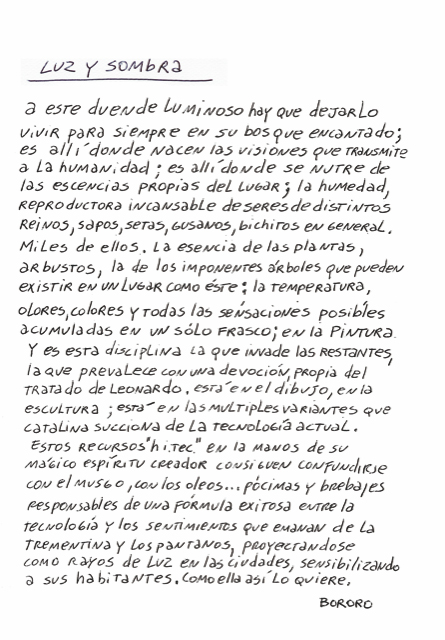
Light and shadow (back cover)
We have to let this luminous dwarf live forever in his enchanted forest; it is there where the visions he transmits to humanity are born; it is there where he nurtures with the essences proper of the place; humidity, a tireless breeder of beings from different kingdoms, toads, mushrooms, worms, bugs in general. Thousands of them.
The essence of plants, bushes, of the imposing trees that are able to exist in a place like this: the temperature, smells, colors, and all of the possible sensations accumulated in a sole jar; in a painting, and this discipline that invades the others, the one prevailing as an option proper of the Treaty of Leonardo. It is in the drawings; in sculpture; it is in the multiple variables Catalina Rojas absorbs from current technology.
These hi-tech resources in the hands of a creative sprit manage to mingle with the moss, with the oil paints… potions and brews responsible of a successful formula among technology and the feelings emanating from the turpentine and the swamps, projecting themselves as rays of light into the cities, making its inhabitants sensitive, as she wants it to be.
Bororo
